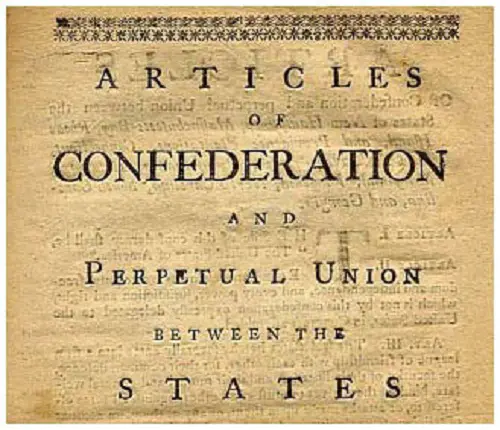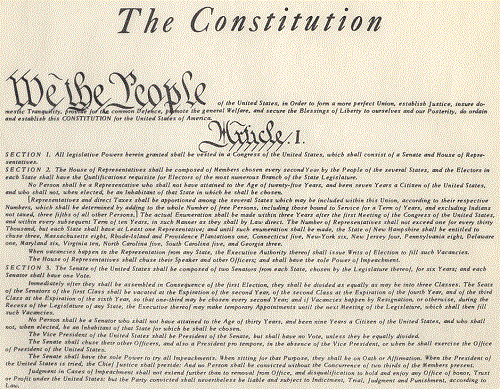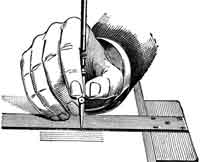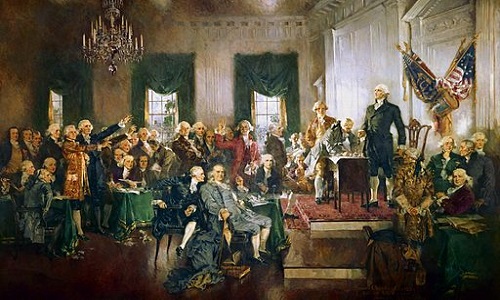
Since the beginning of the American Revolution and the process towards independence from Great Britain, the American States have had the urge to create a centralized government and to set out a comprehensive body of rules and laws to regulate the relations among individual states.
After the signature of the declaration of independence on 4 July 1776, several attempts were made to create a document to establish a centralized government. On 12 July 1776, a committee led by John Dickinson – former president of Delaware and Pennsylvania – presented a draft of the document, which was only made ready for ratification on 15 November 1777. The document – which was completely ratified in 1781 – became the first Constitution of the United States and took the name of “Articles of Confederation.”
The articles asked to all states to enter “a firm league of friendship (…) for their common defense, the security of their liberties, and their mutual and general welfare.” However, the negative experience stemming from the colonial period and the fear of a centralized authoritarian government slowed the process of achieving a widely accepted and supported result.
Even if the Articles of Confederation (AOC) gave several powers to the Congress, the disagreements among states coupled with the lack of a strong government led to the downfall of the AOC, which were replaced by the United States Constitution in 1788.
The articles of Confederation gave to the framers of the Constitution a blueprint. In fact, when drafting the Constitution, all stakeholders focused on:
- The need of a centralized and empowered national government;
- The need of imposing taxes as source of income for the country;
- The need of having a checks and balance system; and
- The need to create a document that could be amendable and changed as needed.
The Articles of Confederation[1]
The main problems encountered while drafting the AOC were linked to:
- The fear of a centralized and authoritarian government;
- The inability to create a clear and comprehensive set of laws to regulate the behavior and the relations among states;
- The limits in the power of the Congress;
- The disagreements regarding the role and the influence of each individual state; and
- The inability to find agreements with respect to the control of the commerce.
However, despite the difficulties, confederates knew that a centralized and unified government was needed to complete the process of independence from Great Britain. Under the Articles, every state retained its “sovereignty, freedom, and independence”, but the Congress was given certain powers. In fact, according to the AOC, the Congress:
- Had jurisdiction over foreign relations and diplomatic ties;
- Had the power to ratify treaties and create alliances;
- Could print and coin money;
- Had the ability to establish a postal service;
- Had the power to request states to pay taxes – although it could not levy taxes;
- Could declare war;
- Had the authority to serve as last resort on appeal of disputes among states;
- Had the authority to run military – although troops had to come from states;
- Had jurisdiction over Native American affairs; and
- Could establish admiralty courts.
However, as the states remained independent and sovereign, the Congress had several restrictions and its power was largely limited. For instance, according to the AOC, the Congress:
- Could not levy taxes;
- Could not impose restrictions on commerce nor on circulation of persons and goods – every citizen of every state enjoyed the “privileges and immunities of free citizens”;
- Did not include the judicial and legislative branches;
- Had no system of Federal Courts;
- Could not directly intervene to regulate disputes among states; and
- Did not have sources of income – as contributions depended entirely on the states.
Furthermore, the decision-making process (of any type) and the amendment of any of the articles posed several challenges. In fact, the Congress needed the assent of 9/13 states to decide on the regulation of coinage, the entrance into treaties etc. while other decisions required a majority. To amend any of the AOC, all thirteen states had to agree.
As the Congress was only constituted by one chamber and the delegates were appointed by state legislatures, each state had only one vote – regardless of the dimensions and of the financial support provided to the central government.

Constitution[2]
As the limits of the Articles of Confederation were clear and the national government was not able to exercise an effective power and control over the country, in 1787 a movement to reform the AOC began in Philadelphia. Keeping in mind the lessons learned from the AOC, the confederates began to draft a new Constitution for the United States. The 13 representatives decided to draft a document that would create a strong, stable, centralized government with enough power to rule the country – but not too much to put fundamental rights at risk. The new government created by the Constitution differs from the Congress set out in the AOC in several ways:
- It is separated into three branches: executive, legislative and judiciary – but no branch is superior to the others;
- It has the authority to levy taxes;
- It has the right to regulate trade between citizens and states;
- It has the power to exercise national authority; and
- It is based on a checks and balance system.
Furthermore, the Constitution also provides for the separation of power between executive, legislative and judiciary branches. According to the new text, the executive body is headed by the President – who is elected by the Electoral College – the judiciary is independent, and the executive body is divided into House of Representatives and Senate.
In order to become effective, the Constitution had to be ratified by at least 9 of the 13 states. After initial debates between Federalists and Anti-Federalists (who opposed the ratification), the Constitution entered into force on 22 June 1788. Since then, it has been amended 27 times.
Similarities[3]
Despite the various differences between the Articles of Confederation and the Constitution, the two texts show some similarities.
- They were both created to provide the framework for a unified, centralized government;
- In both cases, the government is allowed to deal with foreign policy matters, and to sign and ratify treaties;
- In both cases, the government is in charge of the value of the money;
- In both cases, single states cannot declare war or enter into war by themselves;
- In both cases, individual states must respect the document; and
- In both cases, there are term limits for the various offices in the government.
Furthermore, while major changes were made from the first document to the second, the Articles of Confederation were – and are – a pivotal text in the history of the U.S. government. In fact, the lessons learned with the AOC allowed the confederates to create an improved and comprehensive text.
Summary
The Articles of Confederation and the U.S. Constitution were drafted after the newly gained independence from Great Britain. Yet, while both texts aimed at providing the guidelines for the creation of a centralized and unified government, the differences between the two are evident.
- The AOC were limited by the fear of an authoritarian government, while the Constitution creates a powerful and empowered central government;
- The Congress was not able to levy taxes, to control commerce and to directly intervene to regulate disputes among states, while the U.S. government uses taxes as source of revenue, has the ability to control commerce and trade, and can intervene to settle disputes among states;
- The Congress only comprised one chamber and had no legislative and judicial branches, while the current government is divided into executive, legislative and judiciary; and
- The AOC entered into force in 1777 (but where only universally ratified in 1781), while the Constitution entered into force in 1788; and
- The Congress had limited central authority as individual states retained much of their freedom and independence, while the current government has a larger influence over individual states.
Despite the differences, the AOC were essential to the creation of the Constitution, and the two texts maintained some similarities:
- They had the same goal – namely, creating a centralized, independent government;
- In both cases the government could use taxes as source of revenue, but the Congress did not have the power to levy taxes;
- Both Congress and government had the authority to deal with diplomatic, foreign policy matters, including the ratification of treaties and the creation of alliances;
- Both texts could be amended – but with different processes: all states had to agree to amend the AOC while only 3/4 need to agree to start the process of amendment of the Constitution; and
- Both texts had to be respected by individual states.











Leave a Reply